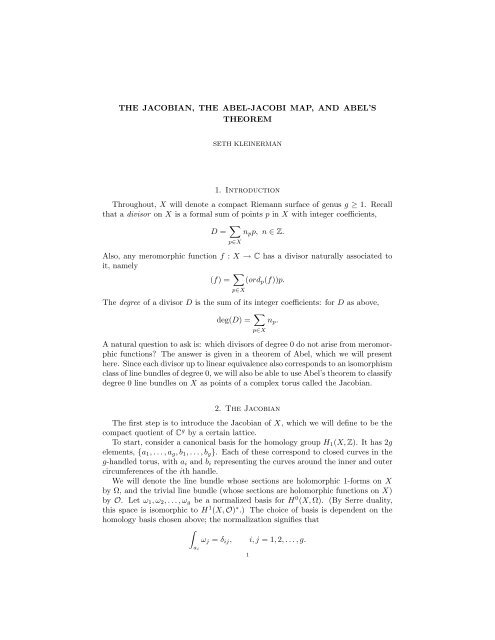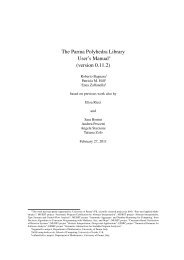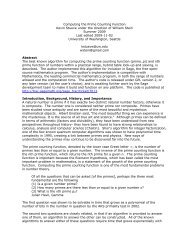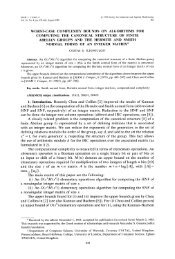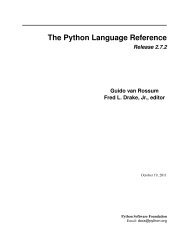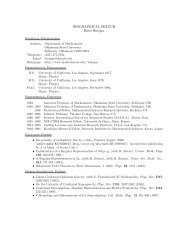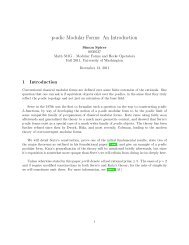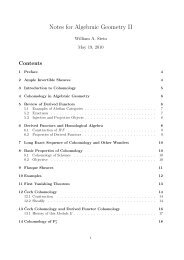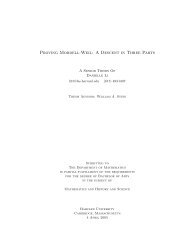THE JACOBIAN, THE ABEL-JACOBI MAP, AND ABEL'S THEOREM ...
THE JACOBIAN, THE ABEL-JACOBI MAP, AND ABEL'S THEOREM ...
THE JACOBIAN, THE ABEL-JACOBI MAP, AND ABEL'S THEOREM ...
Create successful ePaper yourself
Turn your PDF publications into a flip-book with our unique Google optimized e-Paper software.
2 SETH KLEINERMANNow for each curve γ in the homology group H 1 (X, Z), we can associate a vectorλ γ in C g by integrating each of the g 1-forms over γ, as follows:(∫ ∫ ∫ )λ γ = ω 1 , ω 2 , . . . , ω g .γγBecause we have explicitly chosen the ω i s to be normalized with respect to thecanonical homology basis, we see thatλ ai = e i ,the ith orthonormal basis vector, and we can define(∫ ∫)λ bi = ω 1 , ω 2 , . . . , ω g = B i .b i b i∫b iThese 2g vectors (the λ ai s and λ bi s) are in fact R-linearly independent in C g , thatis, no nontrivial linear combination of the vectors with coefficients in R can be equalto zero.Proof. If they were not, for some s i , t i ∈ R not all zero, we would haveg∑g∑s i e i + t i B i = 0.i=1Rewriting this in terms of the original basis, we getg∑)(s i ω j + t i ω j = 0 for each j, so∫a i∫b ii=1i=1g∑)(s i ¯ω j + t i ¯ω j = 0 for each j as well.∫a i∫b ii=1Since the ω i and ¯ω i constitute a basis for the De Rham cohomology HDR 1 (X), our2g equations of the form ∫ γ ω i = 0 and ∫ γ ¯ω i = 0 imply that all integrals of elementsof the cohomology around γ are 0. By Poincaré duality, the homotopy class of thecurve γ must be degenerate, that is,g∑γ = (s i [a 1 ] + t i [b i ]) = 0,i=1where bracketing [a i ] and [b i ] is used to represent their homology classes in H 1 (X, R).However, this last result cannot be true since the set {a 1 , . . . , a g , b 1 , . . . , b g } was chosenat the outset to be the canonical basis for the homology group H 1 (X, Z), andcannot satisfy such an equation.□Therefore these vectors generate a 2g-real-dimensional lattice Λ in C g , which wedefine byΛ = {s 1 e 1 + · · · + s g e g + t 1 B 1 + · · · + t g B g , with s i , t i ∈ Z}.The Jacobian of the Riemann surface X, denoted J(X), is the compact quotientC g /Λ. We can understand it by analogy with the quotient of a real 2g-dimensionalvector space with a 2g-dimensional lattice; it is a complex torus.γ
<strong>THE</strong> <strong><strong>JACOBI</strong>AN</strong>, <strong>THE</strong> <strong>ABEL</strong>-<strong>JACOBI</strong> <strong>MAP</strong>, <strong>AND</strong> <strong>ABEL</strong>’S <strong>THE</strong>OREM 3We can also introduce the Jacobian without relying on a choice of basis, althoughthe resulting structure is less intuitive. Define a map as follows:ϕ : H 1 (X, Z) −→ H 0 (X, Ω) ∗( ∫ )γ ↦−→ ω ↦→ ω .This map takes closed curves in the homology group to the functionals of integrationaround those curves, which are dual to the vector space of holomorphic 1-forms.The image of ϕ is a discrete lattice in H 0 (X, Ω) ∗ , and the Jacobian introducedabove can also be defined as the quotient by this lattice: J(X) = H 0 (X, Ω) ∗ /Im ϕ.3. The Abel-Jacobi MapFix a base point p 0 ∈ X. The Abel-Jacobi map is a map µ : X → J(x). Forevery point p ∈ X, choose a curve c from p 0 to p; define the map µ as follows:(∫ p ∫ p ∫ p)µ(p) = ω 1 , ω 2 , . . . , ω g mod Λ,p 0 p 0 p 0where the integrals are all along c. We have to check that µ(p) is well-defined as amember of J(X), i.e., that the choice of curve c does not affect the value of µ(p).Proof. Choose two curves c, c ′ from p 0 to p. Notice that c − c ′ = γ, a closed curve.We can then write(∫ ∫ ) (∫) (∫ ∫ )ω 1 , . . . , ω g − ω 1 , . . . , ω g = ω 1 , . . . , ω g = λ γ .ccc∫c ′ ′ γγSince γ is a cycle in the homology group H 1 (X, Z), this difference is an elementof the lattice Λ. (To get the element explicitly, write γ in terms of the canonicalhomology basis {a 1 , . . . , a g , b 1 , . . . , b g }, then remember that λ γ is written the sameway in terms of the corresponding basis for the lattice, {e 1 , . . . , e g , B 1 , . . . , B g }.)So the map is well-defined.□After having defined the Abel-Jacobi map on the points of X, it extends todivisors on X by linearity:⎛ ⎞µ ⎝ ∑ n p p⎠ = ∑ n p µ(p).p∈X p∈Xγ4. Abel’s TheoremIn the previous section, we defined the Abel-Jacobi map µ, which brings divisorson X to points of the complex torus J(X). Abel’s theorem classifies divisors bytheir images in the Jacobian.We will need two lemmas; the latter will be stated without proof.Lemma 4.1. For two points p and q in X, we can produce a 1-form which hasa simple pole at both points, is holomorphic everywhere else in X, and carries aresidue of 1 at p and −1 at q. Moreover, we can normalize this 1-form by subtractinga holomorphic 1-form from it; the normalized 1-form, now unique, is denoted ω pq ,and the normalization means that∫a iω pq = 0
4 SETH KLEINERMANfor i = 1, 2, . . . , g.Proof. Consider the divisor p + q. It has a line bundle associated with it, denotedL(p + q). Define Ω(p + q) to be H 0 (Ω ⊗ L(p + q)). We want to find the degree ofthis space. By Riemann-Roch,h 0 (Ω(p + q)) − h 1 (Ω(p + q)) = 1 − g + deg(Ω(p + q)).First, it is a well-known result that the degree of Ω is 2g − 2 (the proof is anapplication of Riemann-Roch and Serre duality), and we know that the degree of(p + q) is 2. Since degrees add, we have deg(Ω(p + q)) = 2g.Now h 1 (Ω(p + q)) = h 0 (L(−p − q)) by Serre duality. But L(−p − q) correspondsto the space of meromorphic functions f on X such that divf − p − q ≥ 0, that is,holomorphic functions on X which have zeroes at p and q. But all the holomorphicfunctions on X are the constant functions, so the dimension of this space is 0.Putting these results together, the equation above now readsh 0 (Ω(p + q)) − 0 = 1 − g + 2g,and we have shown that h 0 (Ω(p + q)) = g + 1. Also since the degree of (p) is 1, thesame argument as above shows that h 0 (Ω(p)) = g, which is the same as h 0 (Ω). Soin order to account for this increase in degree, we must conclude that there existssome meromorphic form with simple poles at p and q.Since it is generally known that the sum of the residues of a form on a compactRiemann surface is 0, we can scale this form by a constant to get residues of 1 and-1 at p, q respectively. Since the space of such forms had dimension 1, this scalingproduces a unique 1-form, which completes the proof of the lemma.□Lemma 4.2 (Reciprocity Law). Let ω 1 , ω 2 , . . . , ω g be a normalized basis for H 0 (X, Ω)as before. Then∫∫ pω pq = 2πi ω k .b k qNote that the right-hand integral does not appear to be well-defined; we thereforehave to specify that it be taken along a curve from q to p that lies within X depictedas a planar 4g-gon before identifications.Theorem 4.3 (Abel). Let D be an divisor of degree 0 on X. Then D is the divisorof a meromorphic function f if and only if µ(D) = 0 in the Jacobian J(X).Proof. The divisor D is of degree 0, so we can write itr∑D = (p k − q k ),k=1with no points p i , q j in common.Suppose D is the divisor of a meromorphic function f. Consider the 1-form df f .It has a simple pole at every point at which f has a zero or a pole. To see this, takethe derivative using the local coordinate wherever f looks like z n for some |n| ≥ 1,and then divide by f: the form is explicitly n z. We also see that the residue at thispole of the 1-form is the degree of the zero or pole of f.So the 1-forms df fand ∑ rk=1 ω p k q khave simple poles in the same places andthe same residues at those poles; by Lemma 4.1, they differ by some holomorphic
<strong>THE</strong> <strong><strong>JACOBI</strong>AN</strong>, <strong>THE</strong> <strong>ABEL</strong>-<strong>JACOBI</strong> <strong>MAP</strong>, <strong>AND</strong> <strong>ABEL</strong>’S <strong>THE</strong>OREM 51-form, which we can write in terms of the ω i basis with coefficients t i ∈ C:dfr∑g∑f − ω pk q k= t i ω i .k=1The next thing we need to notice is that for γ not containing any points p i orq i , the integral ∫ dfγ fequals 2πim for some m ∈ Z. This observation is intuitive, asfollows: for any sufficiently small segment of the curve γ, with endpoints a, b, wecan choose a branch of the natural logarithm function; having made that choice,the form df f= d(log f) is exact, so the integral from one endpoint of the segment tothe other is log b − log a. In the next segment from b to c, we will add log c − log b,using a different choice of logarithmic branch. So as we go around the curve γ, thevalue of the integral will be the sum of the successive differences accumulated bythe two different branch choices at each endpoint of each segment. As such, it willbe an integer multiple of 2πi.In particular, since the above statement is true for all curves γ, note that itsuffices that the integrals around the particular curves a i , b i , the basis for the homologygroup, compute to be elements of 2πiZ. Summing up the proof thus far,we have found that if D is the divisor of a meromorphic function f, we can findt 1 , . . . , t g in C g such that the integrals∫ ( r∑)g∑∫ ( r∑)g∑ω pk q k+ t i ω i and ω pk q k+ t i ω ia i k=1i=1b i k=1i=1are all elements of 2πiZ.Now we will prove the converse of this statement. Assume that we can findsuch elements t i of C g . Define c k , c ′ k to be small circles around p k, q k respectively.Then the homology class of any curve γ in X − ∪ k {p k , q k } is an integral linearcombination of the classes of a i , b i , c k , c ′ k. We compute∫ ( r∑)g∑ω pk q k+ t i ω i = 2πi,c k k=1i=1∫ ( r∑)g∑ω pk q k+ t i ω i = −2πic ′ k k=1i=1by noting that ω pk q khas residue 1 at p k and −1 at q k by definition. So the integral∫ ( r∑)g∑ω pk q k+ t i ω i ∈ 2πiZ,γk=1i=1as needed.Using this last equation, we are able to create a function f whose divisor is D.Choose a base point p 0 ; definei=1f(p) = eR pp 0( P rk=1 ωp k q k +P gi=1 tiωi) .This function is well defined because a different choice of path for the integral wouldresult in the addition of an integral over some closed curve γ, which we have shownabove is an integer multiple of 2πi, so would have no effect. Then we compute∫ (df p r∑)g∑r∑g∑f = d ω pk q k+ t i ω i = ω pk q k+ t i ω i ,p 0 k=1i=1k=1i=1
6 SETH KLEINERMANby a variation of the fundamental theorem of calculus. Hence the divisor of f is D,as we needed.Putting the two halves of the statement together, we see that D is the divisor ofa meromorphic function f if and only if there exist t i ∈ C such that∫ ( r∑)g∑∫ ( r∑)g∑ω pk q k+ t i ω i and ω pk q k+ t i ω ia i k=1i=1b i k=1i=1are all elements of 2πiZ.The normalization condition on the 1-forms ω pk q kand the properties of the basisω i allow the simplification∫ ( r∑)g∑ω pk q k+ t i ω i = t j ,a j k=1i=1since the first integral is zero and the second is normalized. To simplify the integralaround b j , we use the reciprocity law (Lemma 4.2) on the first integral, and thedefinition of B i for the second integral:∫ ( r∑)g∑r∑∫ pk g∑ω pk q k+ t i ω i = 2πi ω j + t i B ij .b j k=1i=1q k i=1The a j integrals are elements of 2πiZ if and only if there exist integers n 1 , . . . , n gsuch thatt j = 2πin j ,and therefore (substituting and dividing by 2πi) the b j integrals are elements of2πiZ if and only if there exist integers m 1 , . . . , m g such thatr∑∫ pk g∑ω j + n i B ij = m j .q kk=1i=1Since this last equation holds for all j, we combine the equations to get the vectorequalityr∑∫ pkg∑g∑ω = − n i B i + m i e ik=1q ki=1where ω = (ω 1 , . . . , ω g ), and this is exactly what we wanted to show: the right-handside of the equation is an element of the lattice Λ by inspection, and the left-handside is the image of the divisor D under the Abel-Jacobi map.□k=1i=15. Jacobi InversionAbel’s theorem demonstrated a correspondence between principal divisors andpoints in the kernel of the Abel-Jacobi map. The Jacobi inversion problem askswhether we can find a divisor that is the preimage for an arbitrary point in theJacobian. The central theorem in this section will demonstrate that it is possible.We start with a lemma.Lemma 5.1. A holomorphic map f : M → N between compact connected complexmanifolds of the same dimension is surjective if the Jacobian matrix of the map hasnonzero determinant at some point of M.
<strong>THE</strong> <strong><strong>JACOBI</strong>AN</strong>, <strong>THE</strong> <strong>ABEL</strong>-<strong>JACOBI</strong> <strong>MAP</strong>, <strong>AND</strong> <strong>ABEL</strong>’S <strong>THE</strong>OREM 7Proof. Because the Jacobian is nonsingular at some point, Im f contains an openset in N. But it is known that Im f is a subvariety of N, that is, that it hasdimension equal to or lower than the manifold N. Since Im f contains an open setin N, it cannot have lower dimension; hence the map is surjective.□With this lemma in mind, we can prove that the Abel-Jacobi map is surjective:Theorem 5.2 (Jacobi Inversion). Every point in J(X) is the image under µ of adegree-0 divisor of the formg∑D = (p i − p 0 ).i=1Proof. Continue to choose a base point p 0 ∈ X for the Abel-Jacobi map. Considerthe space X (d) = X d /S d , the product of X with itself d times modulo elements ofthe symmetric group S d . (Each element of this space consists of exactly d pointsin X, equivalent up to ordering.) Define µ (d) on X (d) to be given by( d∑) ( d∑)µ (d) p i = µ (p i − p 0 ) .i=1i=1Under this reformulation, the Jacobi Inversion Theorem is equivalent to the statementthat the map µ (g) is surjective, where g denotes the genus of X as usual.Consider D = ∑ p i a point of X (g) , with all p i distinct. We have local coordinatesz 1 , . . . , z g on X centered at p 1 , . . . , p g respectively, since X is a Riemannsurface; we then also have a local coordinate (z 1 , . . . , z g ) of X (g) centered at D.Now we compute the Jacobian matrix of µ (d) near the divisor D. (With all theseJacobians floating around, one might get confused—rest assured that we are goingto find the standard Jacobian of a function from vector calculus.) If D ′ is a divisorclose to D, we can write it as the sum of local coordinates ∑ gi=1 z i. We write outthe map in terms of the integrals explicitly and take the partial derivatives of thefunction with respect to the coordinate system:∂∂z i(µ (g) (D ′ )) =∂∂z i(∫ zip 0ω j)= ω j /dz i ,that is, the function which, when multiplied by the form dz i , gives the form ω j . Sothe Jacobian of the function µ (d) at D is the matrix⎛⎞ω 1 /dz 1 · · · ω 1 /dz gJ(µ (d)) ⎜=⎝.. ... ..⎟⎠ω g /dz 1 · · · ω g /dz gOur next goal is to show that we can find a point D at which the above matrixis upper triangular with nonzero diagonal. If we change the local coordinate z i , theith column of the Jacobian matrix is multiplied by some nonzero scalar, but therank of the matrix does not change. So we can put this matrix in upper triangularform without changing its rank, as follows: choose p 1 to be some point where ω 1 isnonzero. Then subtract some scalar times ω 1 from each of the forms ω 2 , . . . , ω g , sothat these forms are all 0 at p 1 . This procedure is a change in the local coordinatez 1 . Now repeat this method, choosing a point p 2 where ω 2 is nonzero under thisnew coordinate and subtracting a multiple of ω 2 from ω 3 , . . . , ω g to make them 0at p 2 ; continuing, we finally find a set of points p 1 , . . . , p g ∈ X and a modified
8 SETH KLEINERMANlocal coordinate such that the Jacobian matrix is upper triangular with nonzerodiagonal.So there is a point D at which the Jacobian matrix of µ (d) is nonsingular, andby Lemma 5.1 the Abel-Jacobi map must be surjective.□The Jacobi Inversion theorem in conjunction with Abel’s theorem implies thatthere is an isomorphism between the space of divisors of degree 0 on X moduloequivalence (the space Pic 0 (X)) and the complex torus J(X). (The Jacobi Inversiontheorem demonstrates that the Abel-Jacobi map is surjective, and Abel’s theoremtells us that its kernel is precisely those divisors that are linearly equivalent to 0.)Since there is already a correspondence between line bundles of degree 0 on X andelements of Pic 0 (X), we have shown that the complex torus J(X) is a moduli spaceof line bundles of degree 0 on X.6. acknowledgementsMy utmost thanks to Alina Marian, who explained it to me.References[1] C.H. Clemens. A Scrapbook of Complex Curve Theory, second edition. American MathematicalSociety, 2003.[2] H.M. Farkas and I. Kra. Riemann Surfaces. Springer-Verlag, 1980.[3] P. Griffiths and J. Harris. Principles of Algebraic Geometry. John Wiley & Sons, 1978.[4] R. Narasimhan. Compact Riemann surfaces. Birkhäuser, 1992.


